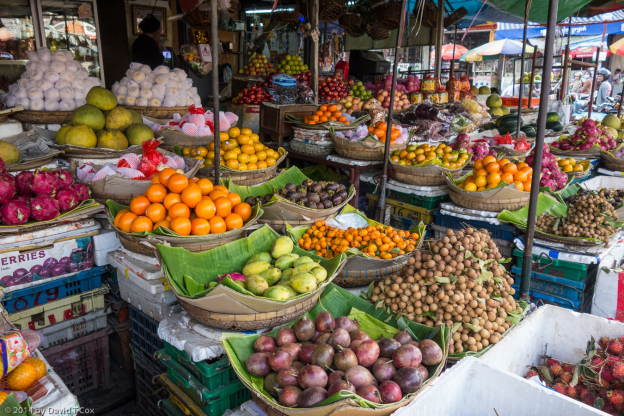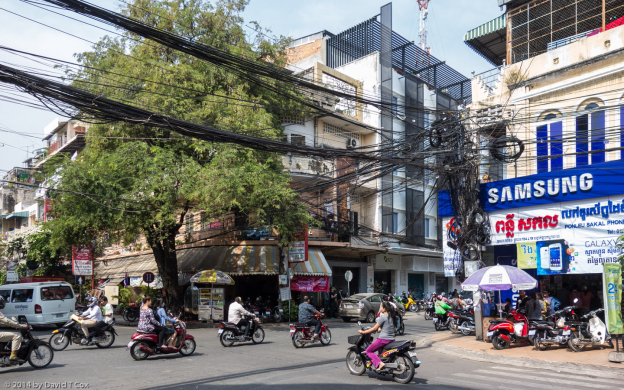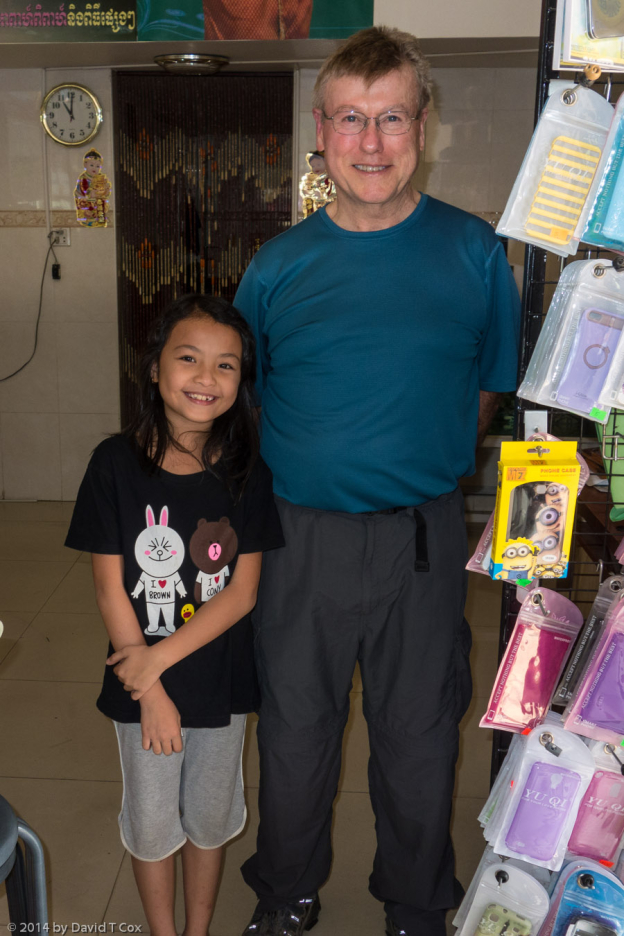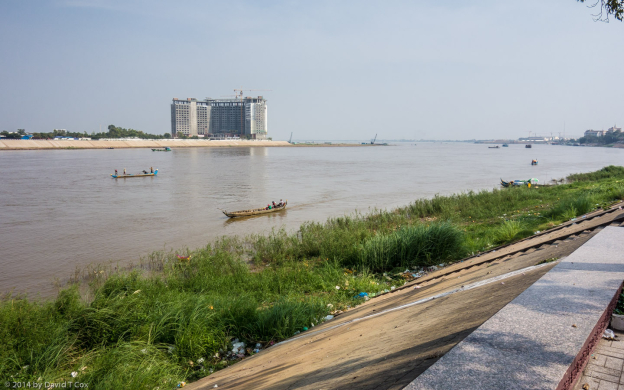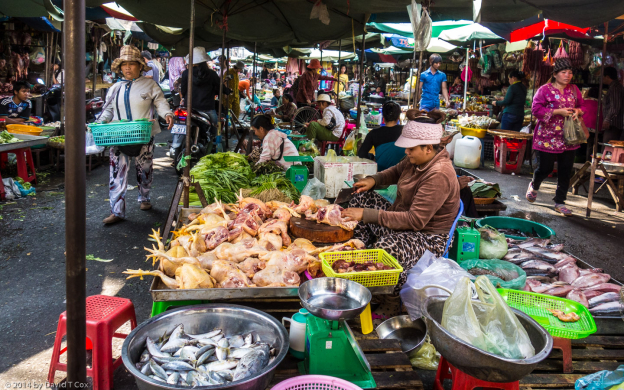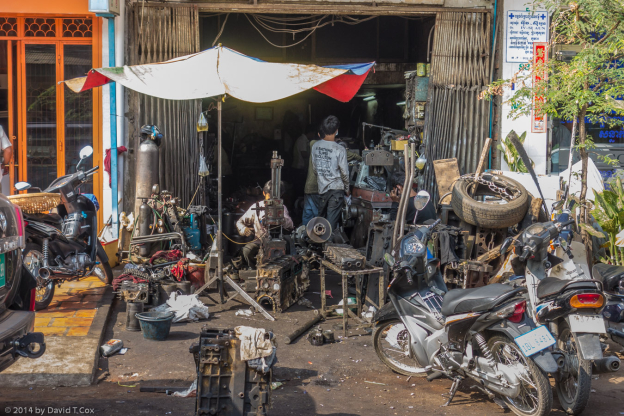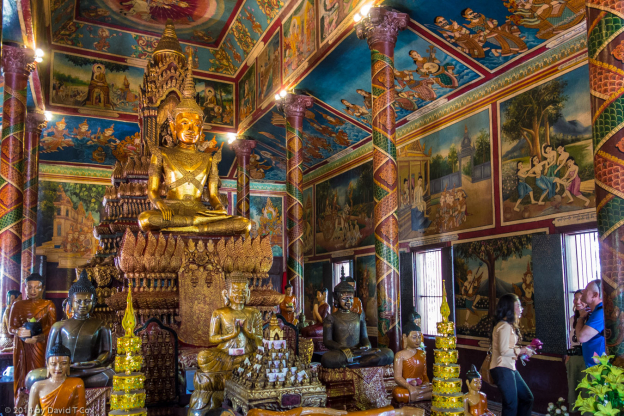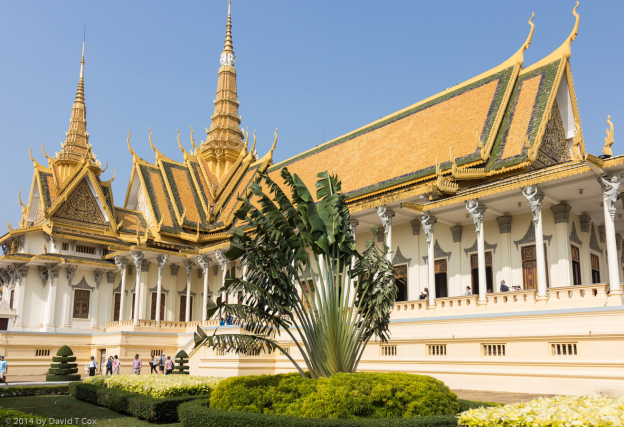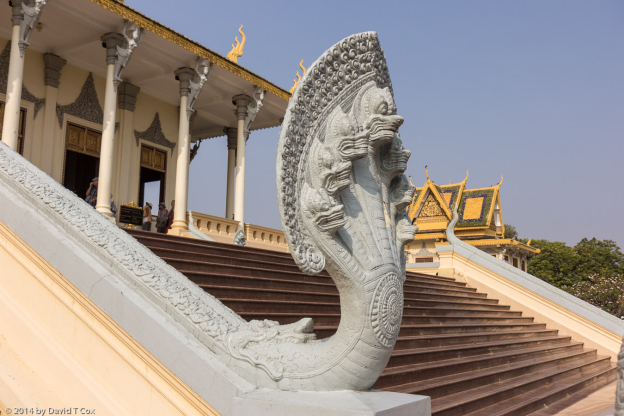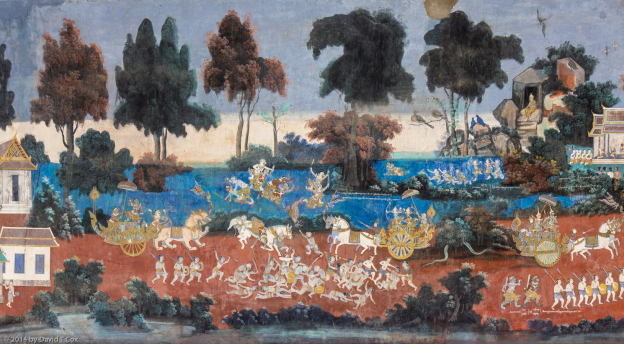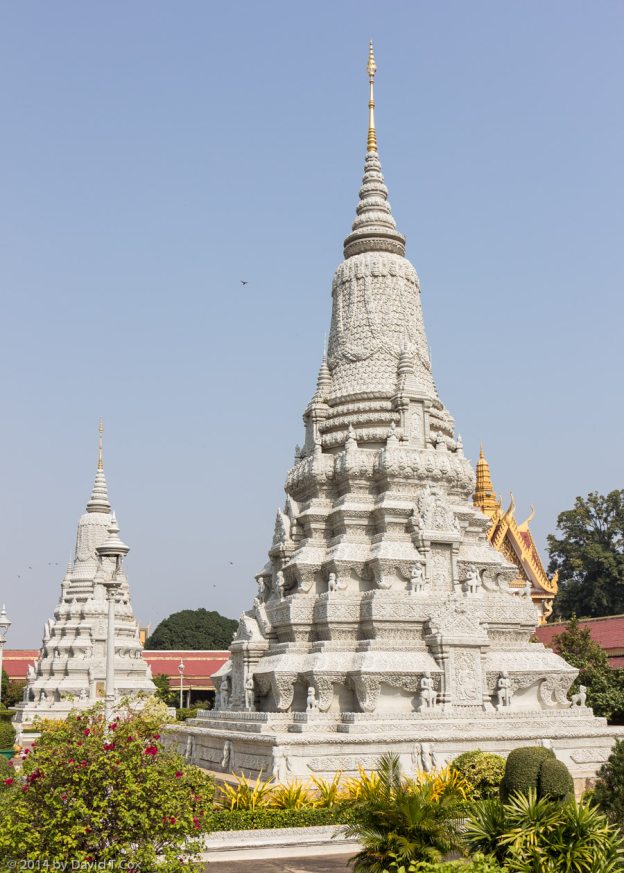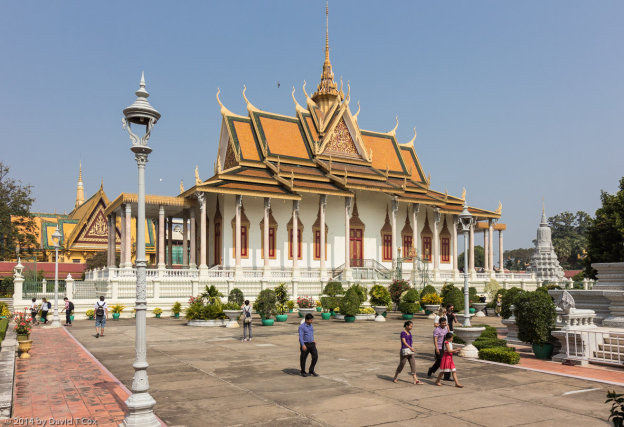All Photos Are Below the Travelogue Text
Click on Any Photo To Open Slide Show
To print the travelogue, right click anywhere on the page. Choose "Print" from your browser dialog box. You can choose Save to PDF in the browser print window.
Share your thoughts.
Email Dave - coxdavid55@hotmail.com
Hello all. I left my home in Tucson 5am Jan 1 and arrived at the hotel in Phnom Penh close to midnight Jan 2 – 29 hours of actual travel plus crossing 10 time zones. Because I traveled West, with the sun, the entire trip occurred in one very very long day (crossing the international dateline accounts for the date change; grueling sitting in an aircraft seat that long. Otherwise no problems with the journey or luggage.
Tucson had definitely passed into its very “cool” range in the weeks before I left ( I would say “cold”, but morning frost doesn’t really compare to the reports from the rest of the country), so the very muggy warm air of Cambodia really hit me the first few days. I have done a fair amount of walking in the last 3 days, South around the Royal Palace and along the Mekong River, and North to Wat Phnom, the shrine on a low hill for which Phnom Penh is named. The main part of the city of interest to tourists lies on the west banks of the Tonle Sap River where it joins the Mekong River, both running South and then turning Southeast at the junction and passing to the start of the long Mekong Delta, which extends on into Vietnam.
My first hotel, Fancy Guesthouse, which I had arranged online and by email in advance, had a small but decent room, but an owner from Hell. I won’t go into detail so as to turn this report overly negative, but, as Mr. Phannak had promised by email to assist me with hiring transportation and finding places to visit, I met with him my first full day in town. What a mistake. Within 30 minutes he was berating me for my inability to speak English (he was having some difficulty), and advising he had never met such an ignorant tourist (I was unsure what to see or where exactly I wished to stop with a private car for the day). He told me to go read my guidebook before I spoke with him about private tours or transport. Thereafter he alternatively ignored me or berated me. As I had reserved the room for 5 days, and he had my credit card number, I was very concerned, and could not eat or sleep that night; fortunately his sister let me check out the next morning. In her broken English I believe she was apologetic, trying to explain that her brother, the owner, had some problems dealing with customers. I’ll say – it was more than a problem – must have been some mental instability. (later I read the negative reports on TripAdvisor; all about the same problem – run-ins with Mr. Phannak).
I moved just two blocks west to the Royal Guesthouse, an accommodation apparently aimed directly at backpackers, but with mostly private rooms, most with baths. I took one of their most expensive double rooms at the top, a large tiled room with old fashioned furnishings and with balcony, AC, TV, Wi-Fi, huge bath with tub and shower, and mini-fridge ($20 per day). More importantly the members of the family, which owns the hotel, all are especially helpful in arranging all forms of public or private tours, transport all over the country and to Vietnam. I found that their posted prices for private car with driver for the day, both in and out of town, were significantly cheaper than my owner from hell had reported – and, of course – the private transport is completely at your disposal. I feel now like I have moved from purgatory to nirvana; in reality I simply am back to what is normal.
Upon arrival, one of my first chores was purchase of a local sim card for a local telephone number. The woman in the shop I was sent to spoke almost no English, but called out her cute little girl, maybe 7 or 8, who spoke very decent English and took over the transaction. She even added time to my sim card on my phone. I watched but had no idea how to navigate through the Android system as she did. I had my photo taken together with the charming sales-rep (see below).
In my first 2 “tourist” mode days I have visited a number of sites, including the old city market which occupies 2 square blocks of city streets in the heart of the city. The stalls sell all manner of colorful fruit and still living catfish trying to swim around the metal trays in which they are confined. Wat Phnom, on a hill to the north, is a Buddhist Pagoda. It is exceptional from the outside, set atop a tree covered hill. The interior is remarkable, with the many versions of the Buddha and the ceiling and wall panels covered in murals. The grounds of the Royal Palace to the south contain many colorful buildings and gardens, best appreciated by the pictures posted below. The main structure is the Throne Room, with its gilded throne and long entrance way. A small museum contains dozens of very large gold and silver ornaments. The grounds just to the south of the Royal Palace are occupied by the Silver Pagoda where the King may worship. The Silver Pagoda itself is so named because its floor is made entirely of silver tiles each weighing over 2 pounds. The tiles number over 5,300, so around 12,000 lbs of silver was employed just for the floor. Inside are numerous Buddha images, made of various semi-precious stone, silver and gold. Quite impressive. The grounds and gardens are filled with monuments and stone chedis. Most amazing and interesting to me are the verandas completely surrounding the grounds; the distance around is 2/3 kilometer – and the walls are completely covered in 8 foot high murals displaying intricate scenes setting out the entire Hindu epic of the Ramayana. The murals were painted in 1903, and unfortunately have suffered damage in a number of places, but are strikingly beautiful where well preserved.
Evidence of the Cambodian garment worker’s labor strikes can be seen in the groups of armed military stationed at various city points. I read that three demonstrators where shot 2 days ago in the south of the city. A German I spoke with was told by the military to get out of a park, as he encountered a demonstration just by Wat Phnom 3 days ago. I can only hope the demonstrations do not further escalate to more violence. Of course I also have been following the political upheaval in Bangkok, where I journey in a month. Neither the Cambodian nor Thai uprisings had hit the news I read when I planned this trip and purchased tickets 7 weeks ago.
Food here generally is very good, with a terrific variety of restaurants. Already I have tried Khmer (the Cambodians are Khmer), Chinese, Western and Indian. Yesterday noon I stopped early in at a little hole named “David’s Homemade Noodles”; I was the only one there at the time. I ordered, of course, fried noodles with pork. As I was drinking cold water at an outside table, waiting for the food, a young man came out to a setup on the sidewalk and started working a huge dough-like lump, just like I used to work hot taffee. He beat the dough then stretched it to full arm spread – then repeated countless times. Finally he started powdering the dough with flour as he stretched it, then folded and stretched, repeating until – voila – he had a huge mass of 4 foot long noodles. A portion of these he dumped briefly into a huge container of boiling water, then drained and plopped them into a searing wok together with veggies and pork. There was my meal, made from scratch before my eyes. It was very good; cost me $2.50.
As to drinks, really surprising – I like the local beer, mostly buying Angkor (60 cents in stores); amusingly, the Angkor beer is often sold right beside Anchor beer – I pointed this out to one store owner, but he didn’t see the irony as he pronounced the name “Anchor” as “an-chore”. Bottled water is exciting to open. The plastic bottles are quite flimsy. The bottles all are filled to overflowing before being capped and sealed. As one is required to firmly grip the bottle while twisting the plastic cap to break the seal, when the seal breaks, several tablespoons of water come gushing out of the bottle. At restaurant tables this means either a wet lap or water on the chicken tikka dish in front of you. In the hotel room it means a wet floor. I am working diligently on a solution that does not involve holding the bottle over a sink. I will report later on my findings.
More challenging than opening bottled water is navigating many of the downtown streets. Finding my way around is relatively easy, but getting from point A to B on foot, without being run down, is challenging. Central streets are filled with a few cars, a few bicycles and pedal-powered 3-wheel carts, more than a few tuk tuks (I’ll describe them later) and countless motorcycles, all moving in never-ending waves. The few stoplights and stop signs I have encountered appear simply advisory, or for the timid; all intersections are a confusing dance of vehicles simultaneously threading around and through each other at right angles. One might advise a pedestrian to stay strictly on the sidewalk, and avoid intersections. Many sidewalks, however, are not used for pedestrians in the heart of the city; practically every square foot of many sidewalks has been converted into mechanic’s shops, where huge engines are broken down, furniture manufacture sites with smelly staining chemicals, motorcycle parking 3 and 4 deep, vendor stalls and cook kitchens for street side eating (remember my homemade noodles). Motorcycles pass slower vehicles by passing around the edges of the street, narrowly dodging objects sticking into the street. A pedestrian, insistent on trying to traverse the city on foot, must therefore walk down the street, and must dart quickly around parked vehicles and rubbish after carefully checking for oncoming traffic. Most natives simply hire the tuk tuks or motos and so meld into the traffic.
The hire of transport around the city comes in 4 flavors; the cheapest and most numerous being “motos” (motorcycles); as many as three people hop on behind the driver (I heard they may not transport more than 1 foreign tourist per moto). Cost $1 to $2 anywhere in town. Much more comfortable are the tuk tuks. When I first read of them, I assumed they were the same as the motor trike transport I have encountered in many other places – 3-wheel tricycles powered by motors, with the driver in front, and a covered seated compartment in back. But tuk tuks in fact are simply motorcycles with a small metal platform attached over the back seat with a hitch to which is attached an actual covered 2 wheel trailer. These are woefully underpowered when full of people or luggage, but much more comfortable than motos; cost is about twice that of a moto – $2 to $4 anywhere in the city. Regular car taxis are also available, but more expensive (they can be relatively cheaply hired by the day either for in city tours or day trips out of town). The final form of transport, used apparently now only by tour groups, are “cylos” – 3 wheel pedal powered tricycles. Completely unlike the rickshaws of India, these have the driver on the single wheel in the back, with the low passenger seat over two wheels in the front. One sees entire tour groups being pedaled in long processions from major sights; normally all the drivers wear bright green vests, I assume so that they can recognize the group and more easily stay together. I would not want to be seated almost at ground level, at the front of the vehicle, approaching the horrific intersections.
The electric power grid is a wonder to behold. Never have I seen such a mess. At street corners the poles are simply covered with hundreds of different wires, coming in and going out to multiple points; between poles, something like 100 different gauge wires dangle in loose aggregations, many apparently broken. Wires snake to dozens of points on the face of every building. No view of the sky from a central city intersections does not pass through cascades of black wires. It would be utterly impossible to follow any particular wire more than a block – no way to follow it through the point of attachment to a pole. See the picture below for a better image. Yet, I have not seen a power fluctuation in the last 6 days, so somehow electricity is reliably transported.
A few more initial observations: Cambodia currency is the Riel, but the US dollar is used by everyone as well. The exchange rate is relatively constant at $1 to 4,000 Riel. In Phnom Penh I have found all transactions can be made in dollars, with the Riel used for change under a dollar. No coins are used or accepted. So if you pay for a $3.60 purchase with a $10 bill, you would get change of a $5 and $1 bill plus a R1,000, a R500 and a R100 Riel bills (each R1,000 is worth 25cents). Amazingly, many cash registers actualy compute the change showing dollars down to the $1 level and then Riels for the change below a dollar. Bottom line, my wallet no longer will hold all the bills, but oh, how wonderful to have no coins dragging the pants down.
On long walks up by the docks on the Tonle Sap River, I found groups of younger kids, naked, playing by sliding on the slimy mud down city drainage channels into the mud/water at the river bank. A part of me was disgusted at the filth, but a small part wanted to join as the boys and girls were screaming with delight as they tried to stay standing while going down the chute. Above the young kids, teenagers sat on the river walls behind a building, completely inebriated as they inhaled something from plastic bags.
As I have confined myself so far to the central city, with few birds, I have not yet tried bird photography. I hope to now start some short explorations outside the city, and will report on that soon. Until later. Dave
To print the travelogue, right click anywhere on the page. Choose "Print" from your browser dialog box. You can choose Save to PDF in the browser print window.
Share your thoughts.
Email Dave - coxdavid55@hotmail.com
